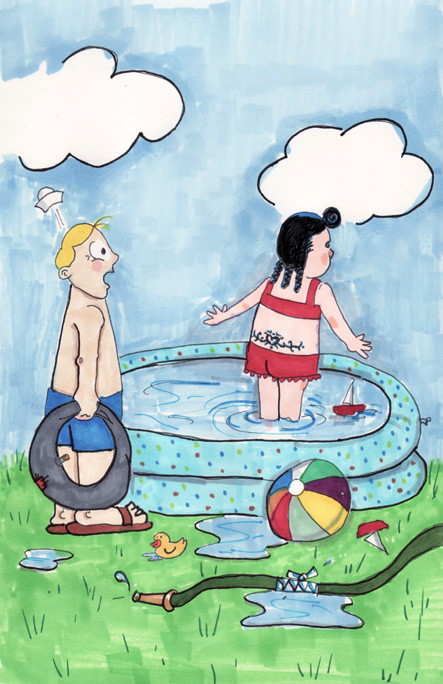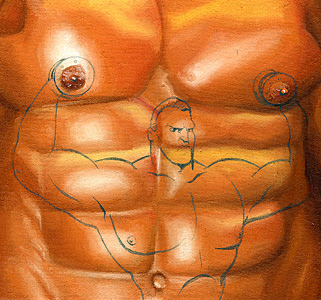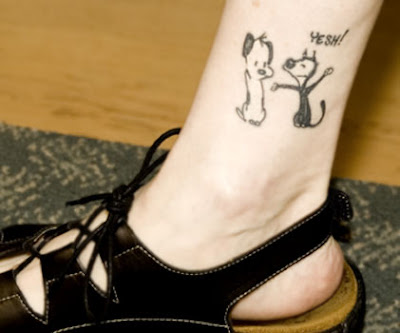 111 writers have won the Nobel Prize in Literature; only a few of them are female. The team at freshessays.com has created the “13 Female Nobel Laureates in Literature” infographic to celebrate these women.
111 writers have won the Nobel Prize in Literature; only a few of them are female. The team at freshessays.com has created the “13 Female Nobel Laureates in Literature” infographic to celebrate these women.
According to visual.ly, the piece showcases the “names of their best novels and poems and words of wisdom.” We’ve embedded the full infographic below for you to explore further—what do you think?
By Katie L. Flanagan
Despite the huge body of evidence that males and females have very different immune systems and responses, few biomedical studies consider sex in their analyses. Sex refers to the intrinsic characteristics that distinguish males from females, whereas gender refers to the socially determined behaviour, roles, or activities that males and females adopt. Male and female immune systems are not the same leading to clear sexual dimorphism in response to infections and vaccination.
In 2010, Nature featured a series of articles aimed at raising awareness of the inherent sex bias in modern day biomedical research and, yet, little has changed since that time. They suggested journals and funders should insist on studies being conducted in both sexes, or that authors should state the sex of animals used in their studies, but, unfortunately, this was not widely adopted.
Even before birth, intrauterine differences begin to differentially shape male and female immune systems. The male intrauterine environment is more inflammatory than that of females, male fetuses produce more androgens and have higher IgE levels, all of which lead to sexual dimorphism before birth. Furthermore, male fetuses have been shown to undergo more epigenetic changes than females with decreased methylation of many immune response genes, probably due to physiological differences.
The X chromosome contains numerous immune response genes, while the Y chromosome encodes for a number of inflammatory pathway genes that can only be expressed in males. Females have two X chromosomes, one of which is inactivated, usually leading to expression of the wild type gene. X inactivation is incomplete or variable, which is thought to contribute to greater inflammatory responses among females. The immunological X and Y chromosome effects will begin to manifest in the womb leading to the sex differences in immunity from birth, which continue throughout life.
MicroRNAs (miRNAs) regulate physiological processes, including cell growth, differentiation, metabolism and apoptosis. Males and females differ in their miRNA expression, even in embryonic stem cells, which is likely to contribute to sex differences in the prevalence, pathogenesis and outcome of infections and vaccination.

Females are born with higher oestriol concentrations than males, while males have more testosterone. Shortly after birth, male infants undergo a ‘mini-puberty’, characterised by a testosterone surge, which peaks at about 3 months of age, while the female effect is variable. Once puberty begins, the ovarian hormones such as oestrogen dominate in females, while testicular-derived androgens dominate in males. Many immune cells express sex hormone receptors, allowing the sex hormones to influence immunity. Very broadly, oestrogens are Th2 biasing and pro-inflammatory, whereas testosterone is Th1 skewing and immunosuppressive. Thus, sex steroids undoubtedly play a major role in sexual dimorphism in immunity throughout life.
Sex differences have been described for almost every commercially available vaccine in use. Females have higher antibody responses to certain vaccines, such as measles, hepatitis B, influenza and tetanus vaccines, while males have better antibody responses to yellow fever, pneumococcal polysaccharide, and meningococcal A and C vaccines. However, the data are conflicting with some studies showing sex effects, whereas other studies show none. Post-vaccination clinical attack rates also vary by sex with females suffering less influenza and males experiencing less pneumococcal disease after vaccination. Females suffer more adverse events to certain vaccines, such as oral polio vaccine and influenza vaccine, while males have more adverse events to other vaccines, such as yellow fever vaccine, suggesting the sex effect varies according to the vaccine given. The existing data hint at higher vaccine-related adverse events in infant males progressing to a female preponderance from adolescence, suggesting a hormonal effect, but this has not been confirmed.
If male and female immune systems behave in opposing directions then clearly analysing them together may well cause effects and responses to be cancelled out. Separate analysis by sex would detect effects that were not seen in the combined analysis. Furthermore, a dominant effect in one of the sexes might be wrongly attributed to both sexes. For drug and vaccine trials this could have serious implications.
Given the huge body of evidence that males and females are so different, why do most scientific studies fail to analyse by sex? Traditionally in science the sexes have been regarded as being equal and the main concern has been to recruit the same number of males and females into studies. Adult females are often not enrolled into drug and vaccine trials because of the potential interference of hormones of the menstrual cycle or risk of pregnancy; thus, most data come from trials conducted in males only. Similarly, the majority of animal studies are conducted in males, although many animal studies fail to disclose the sex of the animals used. Analysing data by sex adds the major disadvantage that sample sizes would need to double in order to have sufficient power to detect significant sex effects. This potentially means double the cost and double the time to conduct the study, in a time when research funding is limited and hard to obtain. Furthermore, since the funders don’t request analysis by sex, and the journals do not ask for it, it is not a major priority in today’s highly competitive research environment.
It is likely that we are missing important scientific information by not investigating more comprehensively how males and females differ in immunological and clinical trials. We are entering an era in which there is increasing discussion regarding personalised medicine. Therefore, it is quite reasonable to imagine that females and males might benefit differently from certain interventions such as vaccines, immunotherapies and drugs. The mindset of the scientific community needs to shift. I appeal to readers to take heed and start to turn the tide in the direction whereby analysis by sex becomes the norm for all immunological and clinical studies. The knowledge gained would be of huge scientific and clinical importance.
Dr Katie Flanagan leads the Infectious Diseases Service at Launceston General Hospital in Tasmania, and is an Adjunct Senior Lecturer in the Department of Immunology at Monash University in Melbourne. She obtained a degree in Physiological Sciences from Oxford University in 1988, and her MBBS from the University of London in 1992. She is a UK and Australia accredited Infectious Diseases Physician. She did a PhD in malaria immunology based at Oxford University (1997 – 2000). She was previously Head of Infant Immunology Research at the MRC Laboratories in The Gambia from 2005-11 where she conducted multiple vaccine trials in neonates and infants.
Dr Katie Flanagan’s editorial, ‘Sexual dimorphism in biomedical research: a call to analyse by sex’, is published in the July issue of Transactions of the Royal Society of Tropical Medicine and Hygiene. Transactions of the Royal Society of Tropical Medicine and Hygiene publishes authoritative and impactful original, peer-reviewed articles and reviews on all aspects of tropical medicine.
Subscribe to the OUPblog via
email or
RSS.
Subscribe to only health and medicine articles on the OUPblog via
email or
RSS.
Image credit: Man and woman arm wrestling, © g_studio, via iStock Photo.
The post Why are sex differences frequently overlooked in biomedical research? appeared first on OUPblog.

Julio Torres, Intern.
Ancient Bodies, Modern Lives: How Evolution Has Shaped Women’s Health written by Wenda Trevathan, Ph.D., a Regents Professor of Anthropology at New Mexico State University, we learn about a range of women’s health issues. Trevathan’s hypothesis is that many of the health challenges faced by women today result from a mismatch between how our bodies have evolved and the contemporary environments in which we live. In the following excerpt, Trevethan draws from Jane Goodall’s observations of primates to illuminate how grandmothers, by virtue of being present in the family, contribute to the growth of prosperity of the grandchildren and the family unit as a whole.
Grandmothers and Reproductive Success
Most long-lived, group-living mammals have in their social groups as many as three generations present at any one time. Examples include elephants, whales and many primates. For primates who live in matrilocal groups, that usually means three generations of females: Infants, their mothers, and their grandmothers. A famous example comes from Jane Goodall’s studies of a Tanzanian chimpanzee social group in which Flo, her adult sons Faben and Figan, and her daughter Fifi lived together. Flo was a high-ranking female and her presence had a number of positive effects on her offspring. For example, Fifi was able to stay in the troop into which she was born, whereas the more typical pattern among chimpanzees appears to be for young females to leave their birth troops at maturity. By staying with her mother, Fifi was also able to rise to a high status. She began reproducing much earlier than most chimpanzee females and not only set the record for reproductive success at Gombe, but one of her sons became the largest male ever recorded at Gombe. Two of Fifi’s sons rose to high status in the dominance hierarchy and her daughter began reproducing much earlier than Fifi did. There is little doubt that grandmother Flo’s status had an effect on her daughter’s (and thus her own) reproductive success. There is no evidence, however, that Flo contributed directly to the care and feeding of her grandchildren, although it is true that she was not in good health at the time Fifi’s first infant was born in 1971.
Anthropologist Sarah Hrdy notes that despite her reproductive success, Flo serves as a good example of why having offspring at later ages may not be a good way to achieve this success or why “stopping early” might be selectively advantageous. Flo reproduced for the last time when she was very old and in poor health, but that infant did not live long. Goodall proposes that this last pregnancy was so draining for her that she was unable to mother her other young offspring, Flint, and when Flo died, Flint died also, even though he as at an age when he should have been able to survive on his own. In fact, if Flo had stopped reproducing after Flint, he probably would have lived, perhaps going on to sire another offspring and increasing Flo’s reproductive fitness through her grandchildren.
Similar evidence that the presence of grandmothers has positive effects on reproductive success comes from observations of a number of other primate species. Again, it is not usually resources and direct care that older female grandmothers provide; rather, they help to defend the infants from other troop members (including infanticidal males) whose behaviors endanger them. In fact, observers report that grandmothers will often act even more vigorously in defense of infants than younger kin. Grandmother Japanese macaques make a significant difference in survival of their grandchildren through the first year of life. Furthermore, females have much greater reproductive success if they have living mothers, even when those older females are still r

I got a request last night on a webpage from a someone who wanted an image of an indian. He wanted me to design a tattoo in my cartoonish style for him. Funny thing is, I don't know the guy, I have never met him and never before spoken to him. I don't know if I will finish the project but it is an interesting idea to put an image in skin.
The challenge for this week at another illustration blog is "tattoo"

Thanks again to this guy for his inspiration.

'Evergreen - Click Image to View Larger Format
I was asked to design a poster for an art show in Mexico called 'DO2'. I had been thinking a lot about the environment and green related topics the past two days after reading an article titled 'Plastic Ocean'. I was inspired to create art that had a green theme to it. I decided to play off the tribal tattoo look but instead of being hard core I gave it a subtle foliage flair while limiting my color palette to greens.
I'd love to get this printed some day on recycled paper using soy inks to really push the whole green aspect of it. I think that would be really cool.
 111 writers have won the Nobel Prize in Literature; only a few of them are female. The team at freshessays.com has created the “13 Female Nobel Laureates in Literature” infographic to celebrate these women.
111 writers have won the Nobel Prize in Literature; only a few of them are female. The team at freshessays.com has created the “13 Female Nobel Laureates in Literature” infographic to celebrate these women.























the expression is great!
Thank you! It was a fun image to draw. Not very tattoo-like yet maybe though :P